Sarah Goer is a San Jose, CA based artist, teacher, lecturer, and pattern designer. As a former math teacher, Sarah is naturally drawn to the math and geometry of quilting and pattern design. Sarah has developed her skills by participating in challenges and swaps and is now eager to share her talents with others. She is currently traveling throughout California to teach workshops and has had three patterns published by Modern By the Yard. In 2018, Sarah became an Island Batik Ambassador, an Aurifil Artisan, and was a finalist for the Craftsty Quilt Designer Fellowship. Her quilts have been featured in Curated Quilts magazine (Issue 3) and have hung at Pacific International Quilt Festival. Welcome, Sarah!
In my own work, I like bold, saturated color with high contrast and sharply defined edges. I enjoy Planned Improv design, as well as more precise piecing. I like the modern traditionalism of designing with a traditional block and editing the blocks to add expansive negative space.
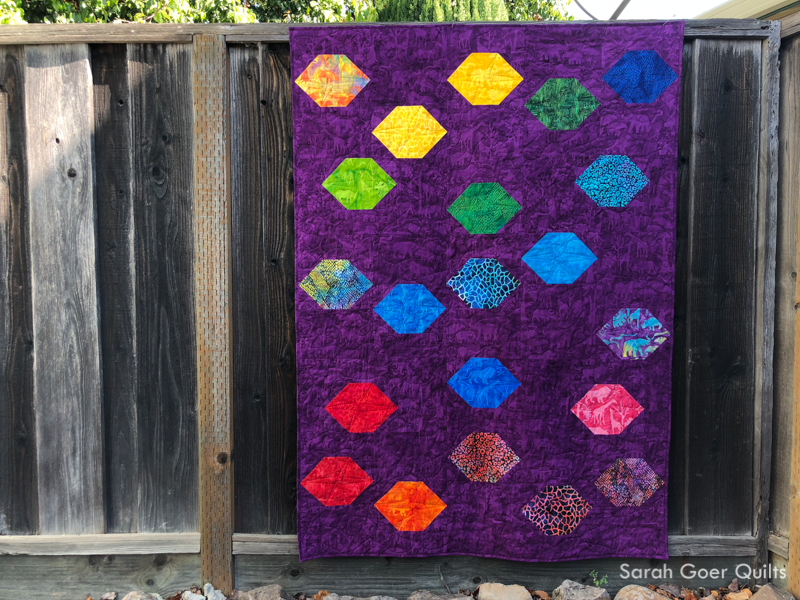
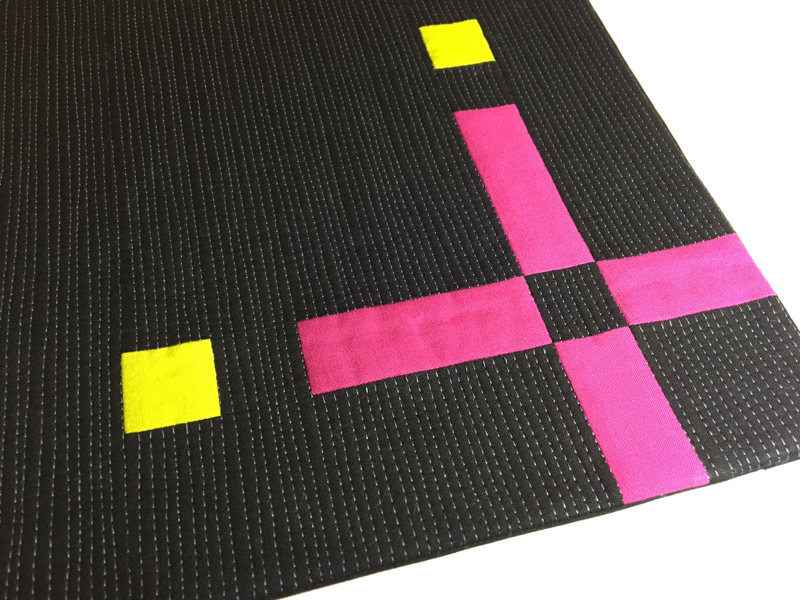
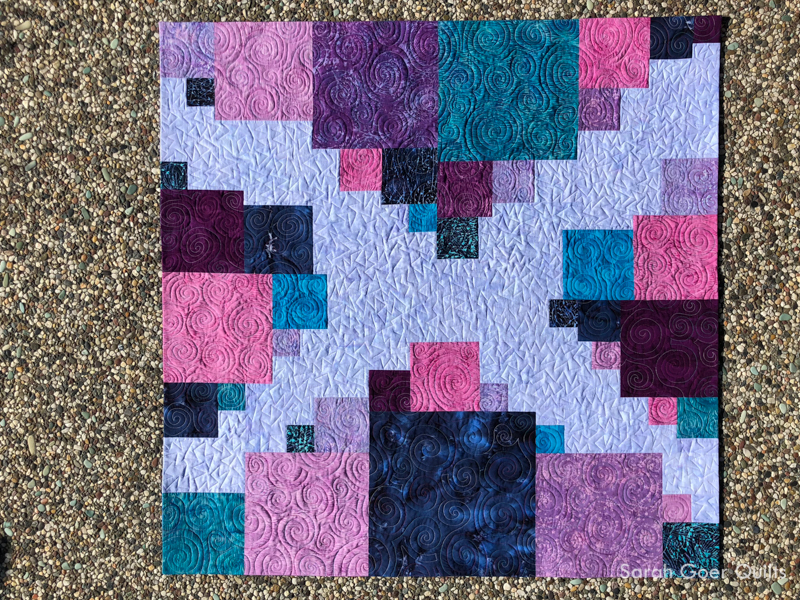
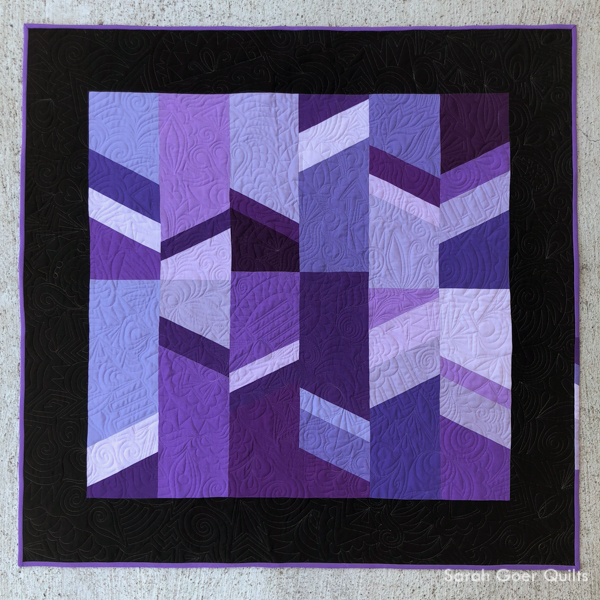
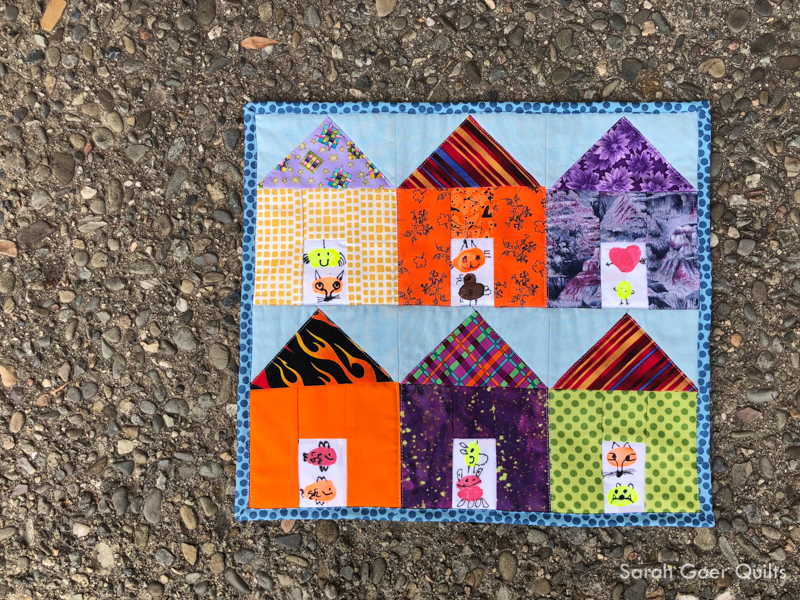
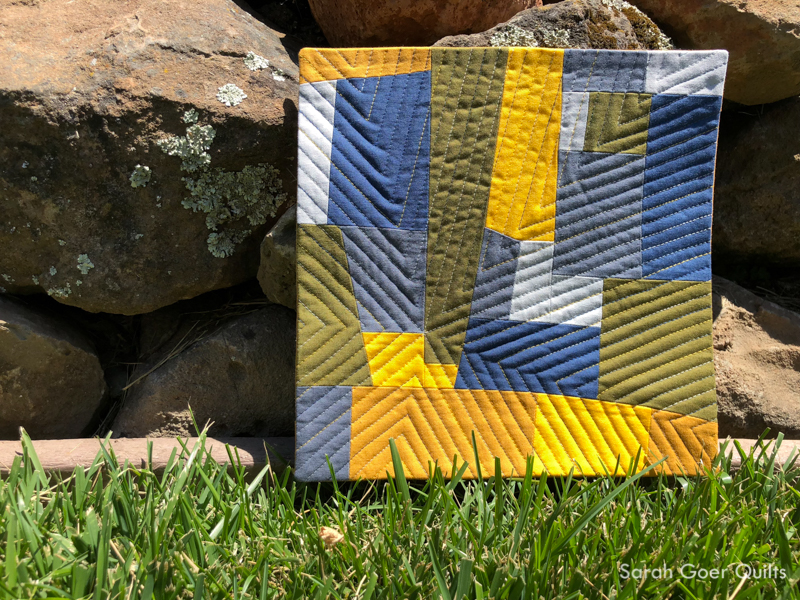
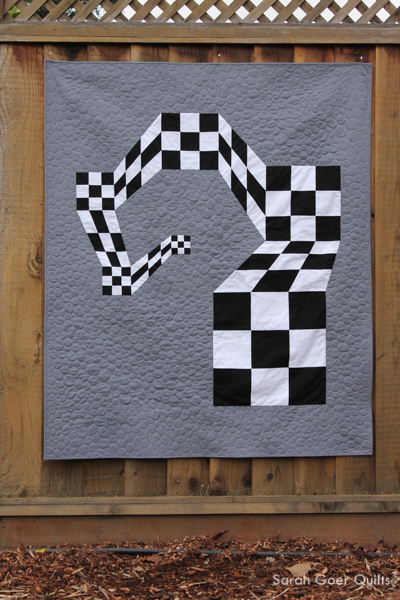
Thank you, Sarah! Best of luck in your new venture teaching quilt workshops! For more about Sarah, visit her website, or connect with her on Instagram. Would you like to be featured in The Creativity Project? Reach out! I’d love to hear from you! Contact me. Want to participate, but not necessarily be featured? You can do that! Click here to take the survey! The Creativity Project can be found on Instagram, Pinterest, Twitter or Bloglovin’. Or check back here every Friday of 2018!
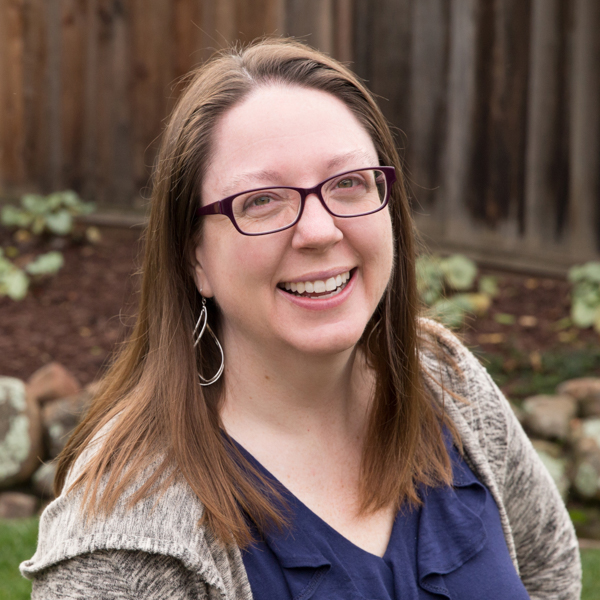 How would you describe your quilting style/aesthetic?
How would you describe your quilting style/aesthetic?
In my own work, I like bold, saturated color with high contrast and sharply defined edges. I enjoy Planned Improv design, as well as more precise piecing. I like the modern traditionalism of designing with a traditional block and editing the blocks to add expansive negative space.

Floating Hexagons. Image courtesy of Sarah Goer.
How would you describe the creative environment in your home as a child?
I grew up around my mom sewing and crafting. She had a craft business for a number of years and I fondly remember hanging out at art and wine festivals when she was vending. As an only child for the first 8 1/2 years of my life, I spent a lot of my play time doing crafty things. Some of my favorite things to do as a kid were reading how-to craft books and using craft supplies or recycled materials. I began sewing on my mother’s sewing machine before I can remember. My very first machine was a Romper Room Sew Easy toy sewing machine. From there, I learned to sew on my mom’s Viking 6690. I made lots of scrunchies — it was the 80’s after all. The Viking 6690 is the machine I still sew and quilt on today, but now I own two of them.What artists and makers do you most admire or have an influence on your work?
There are so many! I learned to free motion quilt from Leah Day’s online videos. She has so much fabulous information for free motion beginners. Christa Watson has been a quilting and business inspiration. Her quilting and “you can do it” attitude is delightful, but what I appreciate more is her helping hand within the industry. Christa has been very giving in sharing her time, experience, and perspective as a pattern designer, fabric designer, and traveling quilt teacher. My local quilty BFF is Mel Beach. We text and share sneak peaks of what we’re working on. She has been a fabulous source of inspiration, moral support, and friendly critique. Beyond that, it always inspires me to see the work of my guildmates, my small group, and the online quilting community.
iMini. Image courtesy of Sarah Goer.
Do you consider yourself a “quilter”, an artist, or some combination of both?
Some combination. I’m definitely a quilter, and I’d say I feel most artistic when working on my own designs, whether that be in the design phase, or when I have pieces up on the design wall. Also, there’s something about facing a quilt instead of using a traditional binding that screams “I’m an artist!” for me.How would you define “making with intention”?
I’m a planner. This carries into my quilting. I like to be thoughtful about the color palette I’m using, the variety of values in the quilt, and the structure of the piece, whether it be precise piecing or Planned Improv.
Modern Batik Scrappy Squares, a class sample for Sarah’s class Planned Improv: Scrappy Squares. Image courtesy of Sarah Goer.
Do you think that having a craft makes us more compassionate? If so, then how?
Yes. From my beginnings as a quilter, there has been a philanthropy arm to my creating. Both of my guilds have philanthropy programs that I have contributed to over the years. Additionally I have made many quilts as gifts. Creating a quilt as a gift is a labor of love. Many hours have been spent thinking of the intended recipient as each piece is stitched. Lastly, I have taught numerous young people to quilt. Working with a person to learn a new skill is an act of compassion. I have enjoyed sharing their excitement at learning a new skill and admiring their finished work.How does creating feed your soul/spiritual purpose?
I have always had creative outlets in my life. For me, it provides a calm space. A little zen in a busy, and often hectic, world. It’s something that I have complete control of and creating has given me unlimited opportunities to learn and grow. Creating has also given me a sense of community. Whether it was an art or craft course I was taking, previous hobbies like paper craft, or the sewing and quilting I do today, I have enjoyed the community of connecting with other makers.
Pantone Ultra Violet All About Angles, a class sample for Sarah’s class Planned Improv: All About Angles. Image courtesy of Sarah Goer.
Are there any rituals that you perform to prepare/ground yourself in your work?
I’m a busy mom with a hectic schedule. I try to sew every day. It brings me balance and sanity. Early on in motherhood, I learned that if I was organized enough to have a pile of pieces ready to chain piece, then I could make a little progress when I only had a few minutes. Those small chunks of time really do add up. With regards to my design work, I usually begin with a doodle or a sketch on graph paper. From there, I can move to the computer to audition colors or to construct the diagrams for a pattern. I spend a lot of time on the computer designing, writing, and blogging so I like that the initial inspiration work starts with paper and pencil. Additionally, when I free motion quilt a new motif, I like to spend time sketching the design on paper to build the muscle memory and sometimes to work out a potential path to a motif.
P1 Village (stitched by kindergarteners in Sarah’s daughter’s class, finished by Sarah). Image courtesy of Sarah Goer.
What is the support system you have in place for creating your work?
I’m fortunate to have a dedicated work space for my sewing and a spouse who helps me carve out time for myself to create. He was also very supportive when I was considering making the jump to becoming a traveling quilt teacher. My kids are quilters, too, so they understand what I’m up to and I can talk with them about what I’m working on. My son recently collaborated with me on a mini quilt for a Curated Quilts challenge. I’m a member of two quilt guilds. The first is a large traditional guild and the second is a smaller modern guild. I love seeing the range of work produced in each group. Once a week I meet with a small quilt group. They are a lovely bunch of quilters and in addition to providing feedback on my work, it is a welcoming, safe space to discuss many aspects of life. I’ve connected with other quilters online through Blogs, Instagram and Facebook. Some of the online quilters I feel most connected with are from when Honest Craftroomies was organizing live video hops on Periscope.
Connections Mini (made by Sarah in collaboration with her son). Image courtesy of Sarah Goer.
How do you deal with comparison to / envy of others? Can you describe a time when you used comparison/envy/admiration to push yourself in your own work and self-discovery?
I’m currently in the process of “turning down the noise” of social media (and other digital distractions) for myself. There is so much to admire in the quilting community online, but I’m in a season of life where I need to use my limited time to create instead of admire. I think it has been easy to feel envious of others who have had their work hanging in shows or published in magazines. The biggest step for me was to put myself out there and submit. I’ve had some acceptances, but also a fair number of rejections. Something that I keep in mind with rejections is that I believe that it’s less about my personal work and more about the cohesiveness of a show. There’s also always another show to submit to.What was the most challenging thing you ever made?
Perspective is a quilt I designed in response to the 2017 QuiltCon 9-patch Challenge. It involved piecing regular and skewed 9-patch units. The design was all done in Adobe Illustrator and I created paper piecing patterns for the skewed units. Then it was a puzzle of algebra to cut out the right triangle units of background fabric to fill in around the 9-patch units. I’m thrilled with how the geometry came together, but it was a bit of a struggle.
Perspective. Image courtesy of Sarah Goer.
What does it mean to you to work in a traditionally domestic medium that historically has been regarded as predominately female (aka “women’s work”)?
I honestly don’t think too much about it. In my work and in sharing my work in the creative world I don’t feel like it affects me too much. While quilting may still be a primarily women’s craft, our quilting community is rich and diverse. I enjoy the different perspectives I see from other quilters. Personally, the way I’m most affected may be that I have taught my son to quilt. He’s 8 now, and has been quilting since he was 4 1/2. It’s not lost on him that my quilt guild is mostly women, but he’s too young to be bothered by this fact. Two and a half years ago I brought my son to see Rob Appell speak at our guild meeting. It was a nice chance to drive home the idea that men quilt, too. I also like to share Giuseppe’s work on IG with my son.How do you see your current work in the context of quilting history?
Ever since I was a new quilter I was inspired by seeing the work of others at show and tell during guild meetings. That inspiration is what led me to share my work on my blog in the hopes of inspiring others in their quilt projects. Having recently begun teaching quilt workshops, I’m excited to be working with quilters directly. I really love the one-on-one discussions, as I move around the room while I teach. As a former middle school math teacher, I’m glad to be back in the classroom in a fun, new way. Anything I can do to help a quilter become more comfortable with or get excited about a new technique is a win! It’s been fun to see the twists people have put on the techniques learned in my workshops.Thank you, Sarah! Best of luck in your new venture teaching quilt workshops! For more about Sarah, visit her website, or connect with her on Instagram. Would you like to be featured in The Creativity Project? Reach out! I’d love to hear from you! Contact me. Want to participate, but not necessarily be featured? You can do that! Click here to take the survey! The Creativity Project can be found on Instagram, Pinterest, Twitter or Bloglovin’. Or check back here every Friday of 2018!

I love that Sarah’s children are quilter’s, too, and I love her approach and thoughts on teaching: “Working with a person to learn a new skill is an act of compassion.”
So right on. To me, an intrinsic part of quilting is that it’s an art that is passed down from generation to generation. Learning Sarah has been bringing in her children already is so great to see.